We organize weekend group gold prospecting adventures during the summer months. All active members are encouraged to participate. There is no charge for active members. We appreciate it if you call ahead with your plans so we can plan in advance for how many people will attend.
The initial purpose of these projects is to provide hands-on learning experience under the guidance of multiple experienced members in hopes that it will improve your own ability to go out and find high-grade gold. This has been an important part of our successful operating basis for more than 30 years.
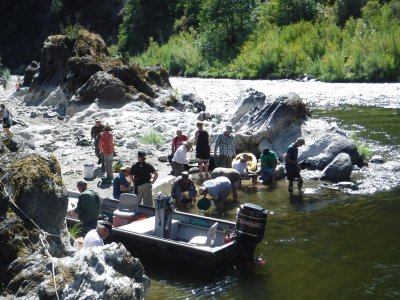
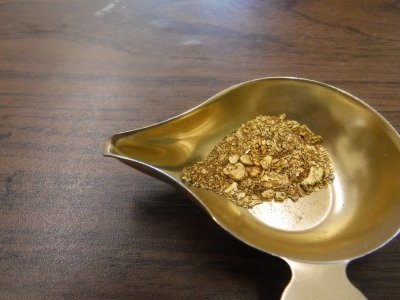
More recently, because the State of California has forbidden small-scale gold miners the use of motorized systems within 100 yards of a waterway, The New 49’ers, with our substantial resources, have the capability to increase gold recovery because we can fabricate specialized gear, we have intimate knowledge of where the gold is traveling in, and to the sides of the river, and because we are fortunate to have a dozen or so very experienced members who come out and help manage the program. Everyone who participates on Sunday receives an equal share of the gold that we recover.
This was the final weekend project of last season. About 70 members participated, including at least ten experienced helpers. We used my jet boat to ferry participants almost directly across from a primitive river access downstream from the very large parking and camping area on our very popular Wingate property.
Normally, myself with several helpers, verify in advance that the gold deposit we will work is going to produce well for the group project. Once we are sure about the area, a day or two before the project, we pull a larger group of members together and move all our gear to the site. If the area is somewhat difficult, or if it is on the far side of the river, we drop the gear off at an easier access point and use my boat to move the gear to the site. If the floating sluice is being moved, we can transfer everything to a new location in three boat loads.
The gold is plentiful all along the extensive Klamath River properties and side tributaries which we make available to our members. High-grade gold it is generally, but not always, more plentiful and easier to find if you can get across the river. This is, in part, because fewer people have prospected on the other side. There is also something mysterious about the nature of raw gold in that the best deposits usually are located in the places that are more difficult to reach.
This prompted us many years ago to buy a variety of different kinds of watercraft to help us move people and gear across the river; or sometimes, to places along the river that you cannot reach without a boat. Diane Helgesen captured Craig Colt and I hot-dogging it a bit on the river. This is extreme adventure at its best. Though we normally do not run around like this when we have project participants in the boat:
In addition to the increased access which the boat makes possible, adding some boat voyages along the river adds more substance to the outdoor adventure for everyone involved. We also use the boat to help disabled members gain easier access by picking them up and dropping them off at the closest developed river access where vehicles are able to reach the river. In this case, there is a semi-developed campground and river access about a quarter mile upriver from our project site.
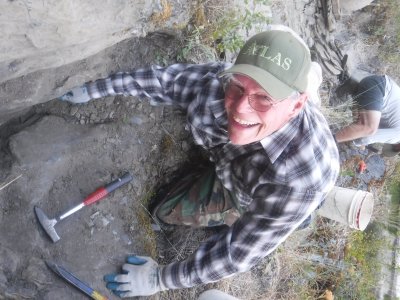
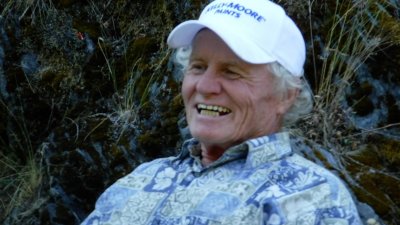
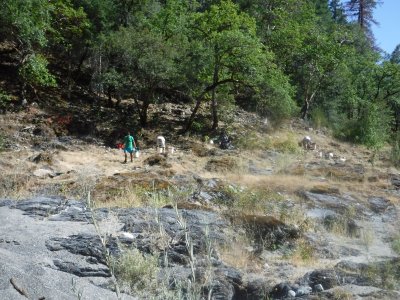
This rich gold discovery turns out to be a massive area of exposed and shallow bedrock on the far side of the river.
Special mention should go to the dozen or so very dedicated helpers who contribute their valuable time to devote an occasional weekend helping less-experienced prospectors learn, and to help me make sure that the projects come out well on Sunday afternoon. This means minimizing any accidents (once in a while, someone will take a fall on the rocks), making sure participants are digging the best pay-dirt we have discovered at the site, and watching closely to make sure we are not feeding the recovery system too fast or losing gold in some other way. We could not put on these weekend projects without our volunteer helpers.
We did not need to sample this site in advance of this particular project. This is because we were out on the same site with a group earlier in the season. Once again, Dr. Gold made the discovery by bringing down a bunch of beautiful gold nuggets that he was picking right off the bedrock. I wrote that story up in our August newsletter.
While expanding on Dr. Gold’s discovery, we realized that there appears to be a vast area of exposed bedrock which has gold lying all over it. Some areas have some shallow streambed on top of the bedrock which is also producing gold. The area is perfect for crevicing and non-motorized mining. Most importantly, we discovered on this project that it appears the historical miners decided to work the gold deposits on an upper plateau and throw their tailing cobbles down the hillside on top of virgin, shallow bedrock “Virgin streambed” is stream bottom that has never been mined before. This is a very important development, because we seldom find virgin streambed up out of the water where the historical miners were able to reach. Check this out; you can see it for yourself:
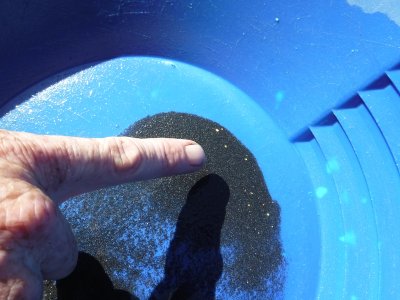
Some of the sample pans were looking like this or better!
We always begin these projects on Saturday morning in a classroom setting in Happy Camp where we can do introductions and start building the team spirit which will flourish as soon as we begin recovering gold out of the ground. Then I take until lunch to present a simple talk on how to follow an organized sample plan, step by step, into high-grade gold deposits. Other than relying upon luck alone, the sample plan is a proven method of following the positive signs to discover the path that gold is following down the river and its banks, and what particular layer in the streambed contains the concentrations of gold. This information becomes more meaningful when we get out in the field and begin sampling.
Saturday afternoon is meant to be light duty. Mainly, we are trying to pinpoint the places where we will dig on Sunday. We also want to make sure everyone knows how to effectively manage a gold pan. Learning to pan for gold is the first important step in the learning curve. Said another way, if you cannot pan streambed material without losing gold, you cannot do a proper job of sampling. Sampling is the whole key to finding rich gold deposits.
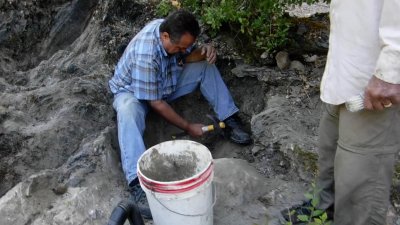
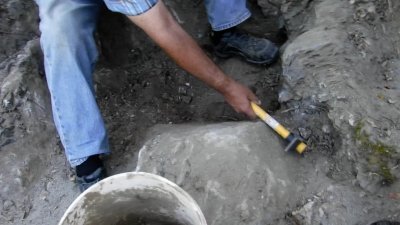
There was already a member out there who had set up his own hand-sluice in the shallower water near the edge of the river. He showed us the gold he had recovered on the day before. It looked really good! Here it is on video:
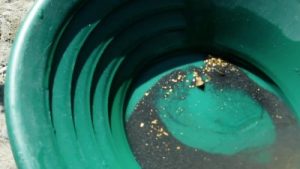
Gold one member recovered with his hand-sluice!
We don’t like to push it too hard on Saturday. This is because some people will not be used to this sort of physical activity during the hottest part of the day. But when you start uncovering gold in your pan, it’s a real challenge to not turn up the steam! Often, the ones who overdo it on Saturday don’t show up on early Sunday morning. Sunday is when we all pull together as a team to recover as much gold as we can in several hours of steady work. Everyone who is out there helping on Sunday is entitled to an equal share of the gold we recover.
Nearly every pan was producing a good showing of gold. There were only a few people on this project that needed some help with their panning. So we were only on the far side of the river for less than two hours. I was seeing some nice gold, including nuggets.
To get a head start on Sunday morning, my helpers and I carefully moved our floating sluice out into the river and set the water flow for optimum gold recovery. This is a larger sluice recovery system that we float right at the water’s surface. We can adjust how deep the front of the sluice dips into the moving water to set how fast our pay-dirt will be washed through the recovery system. Here was some of the action on video:
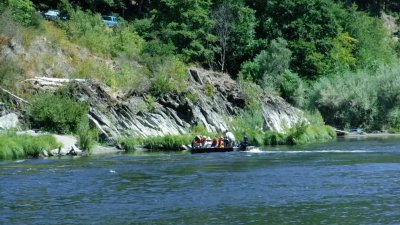
Fortunately, the boat landing was almost directly across the river from where we would be prospecting. Participants were following a primitive path to and from their cars.
I started bringing people back across the river at around 4 PM on Saturday afternoon. It took maybe ten trips to move about 70 people across the river. It all happens pretty fast because my helpers fit everyone into a life preserver before I return for the next load. There was plenty of time remaining for everyone to freshen up and pull something together for our Saturday evening potluck in Happy Camp.
Potluck was more than a full house of enthusiastic members. There was a large variety of food; plenty for everyone. I guess because I was so pleased during the previous potluck because someone brought a full plate of nicely-cooked beef, someone brought me a fat, juicy steak that was cooked rare, just the way I like it. I ate the whole darn thing!
We try to keep these potlucks short so people can get plenty of rest and sleep to be ready for the real action that will take place on Sunday morning. We start early so we can finish the physical work before the heat of the day reaches the project site.
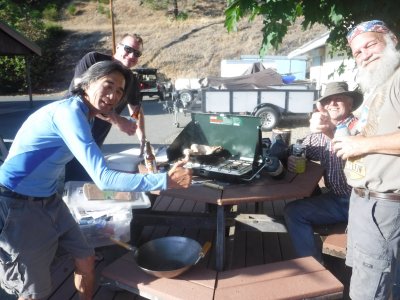
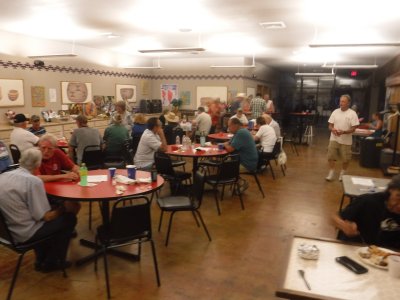
I arrived down at the landing at 6 AM exactly on Sunday morning. This turned out to be a mistake; something I don’t remember that we ever encountered before. Because we were in the later part of August, it was still nearly pitch dark out on the river. I have been driving boats on the Klamath River for so long, I can do it in the dark! But that’s when there is enough water in the river to float the boat.
Sometimes late in the summer, the authorities fluctuate the amount of water discharging from the first dam upriver. These important changes either increase or decrease the speed and depth of the river. Out there in the dark, I did not see that the river had dropped by four or five inches overnight.
Oh Oh!
I didn’t realize the danger until we encountered the first of several aggressive sets of rapids. Late in the summer when the water in the river is low, there often is just one way through the shallow rapids. My challenge is to speed through the deeper water that lies between the shallow bar (all rocks) on the road side of the river and the truly dangerous fast water that is flowing over and around huge boulders on the far side. The margin for error is very close. Going downstream, I doubt that the boat will survive getting caught up in the boulders on the far side.
It is pretty easy for me to power the boat down the safe path when I can see where it is.
It was impossible to determine the safe path through the rapids because the river had dropped and changed all the flow dynamics. In the dark, the river was taking us downstream too fast to figure out the safest path. I knew we were in trouble. There is no changing your mind once a powerful river is washing you down through angry water. You just have to make the best of it – which means being prepared to abandon ship if the boat gets flipped over.
I will trade a few more dents on the bottom of my boat any day rather than take a chance on sinking it with a full boat of disabled passengers! I think my passengers believed that this was just a normal part of the adventure – until we started bouncing over rocks…
With five disabled people in the boat, since I could not see the slightly deeper slot out in the middle, I decided it was better to err on the shallow side of the river where the rocks are smaller.
Boom! Slam! Smash!
I cut the corner too close; and the boat was slamming over the rocks as we were swept downriver by the extremely fast, shallow water. Even though we were bumping rocks in the shallow water, I used the powerful motor to keep the boat pointed down river and away from the dragon tooth boulders that were looking to eat us for breakfast. Luckily, we made it through without doing any serious damage to the boat. By “serious,” I mean the engine will not run, or the boat is sinking. Serious damage would put an end to the Sunday program on the far side of the river. Fortunately, none of my passengers were hurt, though they were shaken up a bit. So was I!
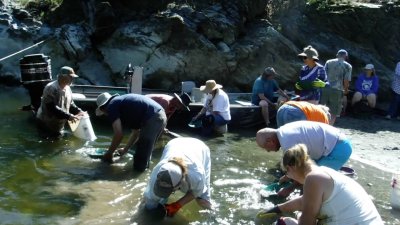 We rounded the next bend to find the entire landing site crowded with people out there standing in the dark. Talking about dedication; everyone showed up early! The landing site was not in direct view of where the boat stumbled over the rocks. So they did not see our rocky ride. But they heard the noise of our collisions from about a quarter mile away. They said it was quite loud and sounded like we met our end. But that was not enough to keep the first bunch from putting their life preservers on and being ready to board the boat!
We rounded the next bend to find the entire landing site crowded with people out there standing in the dark. Talking about dedication; everyone showed up early! The landing site was not in direct view of where the boat stumbled over the rocks. So they did not see our rocky ride. But they heard the noise of our collisions from about a quarter mile away. They said it was quite loud and sounded like we met our end. But that was not enough to keep the first bunch from putting their life preservers on and being ready to board the boat!
Thirty minutes later, we had the entire crew over on the other side of the river. Our project helpers organized everyone into teams, working several different locations that produced nice gold nuggets on Saturday afternoon. Some people were digging. Others were carrying half-filled buckets down to a large classification screen which is designed to split the pay-dirt into two sizes: (1) the material passing through a quarter-inch mesh screen, and (2) the larger sized material. Everyone was busy. Enthusiasm was everywhere. That’s saying a lot for first light on a Sunday morning! It was a cold August morning out there!
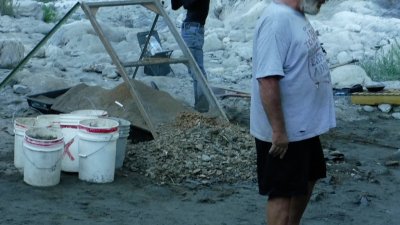 As the pay-dirt was run over the screen, others were filling buckets with the screened material. That’s the normal material that we feed into our recovery system. We usually don’t do anything with the oversized material that does not pass through the screen. But in the previous project we did in this location, we recovered dozens of nuggets – some which appeared too large to pass through a quarter-inch screen. We are not accustomed to digging in places which have so many gold nuggets.
As the pay-dirt was run over the screen, others were filling buckets with the screened material. That’s the normal material that we feed into our recovery system. We usually don’t do anything with the oversized material that does not pass through the screen. But in the previous project we did in this location, we recovered dozens of nuggets – some which appeared too large to pass through a quarter-inch screen. We are not accustomed to digging in places which have so many gold nuggets.
When we were doing that earlier final clean-up, it occurred to me we should be panning the oversized material. So we started doing that on this project. One helper recovered four nice gold nuggets in just the first two buckets of oversize that he panned! Diane captured some video of my explanation and demonstration about the importance of processing larger-sized material when you are digging in a gold deposit that is producing nuggets. As long as things are going smooth, we do joke around a little bit to keep the mood upbeat and fun:
Another problem we have been struggling with as these projects are becoming more popular is that the participants can dig more pay-dirt than our recovery system can process. I’ll bet we left 25% of the pay-dirt we dug just sitting there on the bank during the previous project. Some participants were so jacked up to process the pay-dirt we left behind that they skipped the gold split altogether and swam over there with their gold pans!
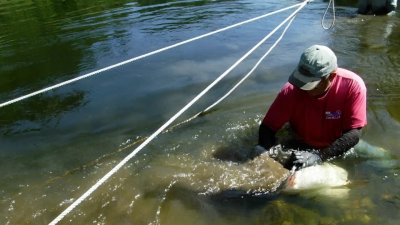
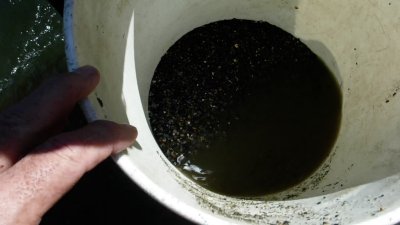
We reduced the volume of pay-dirt by allowing the river’s flow to wash away most of the lighter fine particles.
This time, we tried something different. The dry, screened material was put into buckets which were submerged in shallow water. Swirling the material around caused the lightest material in the bucket to wash out. Gold is far too heavy to wash out of a bucket in this way. This method reduced the ultimate volume of pay-dirt to less than half. In this way, we were able to process all the heavier pay-dirt that we dug. Here we caught this on video:
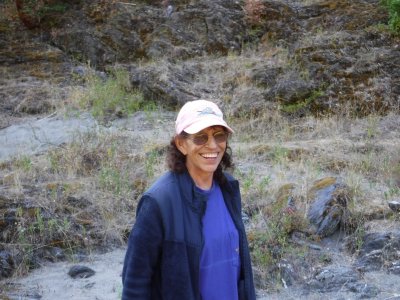
Diane Helgesen
Diane Helgesen is one of our most loyal and supportive members. She never misses a New 49’er event. She is designated as the “Gold Girl” during these projects. The Gold Girl keeps a plastic bucket with locking lid. Every time someone comes up with a nugget, or a handful of nuggets, or a good gold pan, Diane is right there on Sunday making sure all the gold ends up in the bucket. She also takes over the camera when I am going to give an explanation or demonstration. We have a lot of fun with the camera. Some of our fun usually is not appropriate for these newsletters. If you believe I went too far this time, drop me an email and let me know.
During the summer months, there is usually a steady stream of rafters floating down the river. These days, they are all mostly friendly. It didn’t always used to be like that. When we first began on the Klamath River in 1984, we were pretty-much the first modern day gold miners along the river. We were newcomers to long-established rafting companies who were not accustomed to sharing their river experience with us. But that was so long ago, we have now been on the river longer than most of today’s rafters. If we have gold to show, we always invite them over to have a look. Most of the rafting guides these days appreciate that our gold mining activity creates more interesting things for their customers to see. Here is some of that on video:
In fact, just in the last two years, I have noticed that there appears to be some kind of Renaissance happening that is lightening up the mood of our members, and even the people outside of our association. I say this because I have devoted nearly my entire adult life to helping others find gold – which is a very emotional activity. Especially when someone is not finding any! Diane captured the following video as I summarized what was happening further up the hillside and then got off on a sidetrack about how much more friendly people seem to be getting. We decided to not edit out my joking around to demonstrate that I have a lighter side even though it is not always visible:
Craig Colt is a longtime loyal friend and helper who is perhaps the best prospector I know (except for Dr. Gold). He was up the hillside near where the handfuls of nuggets were recovered on the previous project. And sure enough, several guys who were following Craig’s direction were recovering nuggets off the bedrock one right after the other. I snapped off one image of a bunch of nuggets in one person’s hand!
Craig led a team to the pay-dirt where one guy was recovering nuggets that could be picked off the bedrock!
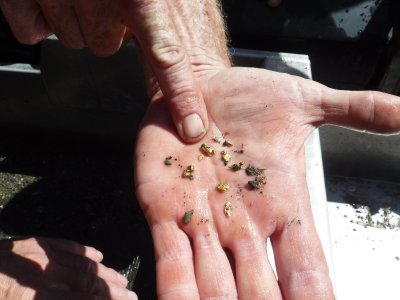
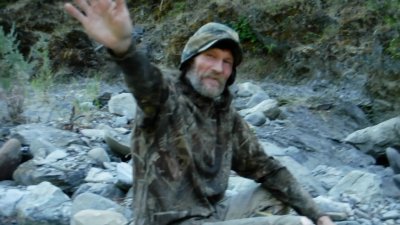
We have been doing these group projects every season since 1987, so we have the program dialed in pretty well. Though we continue to learn more each time we do it. As overall project leader, I am down to two nagging worries that are not entirely under my control. The first is the possibility of someone getting hurt out there. We are walking around on uneven ground with loose rocks. There have been some falls over the years; none worse than the falls I have taken. Still, the possibility of someone slamming his or her head into the rocks is an ever-present concern. We insist that all participants wear shoes or sneakers to try and avoid as much of this as possible.
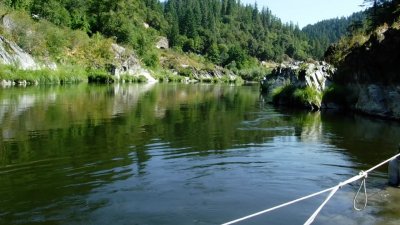
With more than 70 miles of gold properties available to our members, there are no shortage of places where we can find plenty of gold.
My second worry is that we will not recover enough gold to split amongst all the participants. This happened several times during our early years when we were not as familiar with our mining properties. These days, we have year-around members present that do nothing but prospect on our properties. In turn, they whisper to me about the hot spots they have found that can be worked on these projects.
While individual prospectors only need a small pull-off on the side of the road to park their car, and can dangle a rope to get up and down a steep embankment; these projects require lots of parking area, a rather easy trail down to the river, a toilet that is not far away; and using the boat if necessary to get back and forth to a river access where we can launch gear and recover it later.
Numerous members have made good discoveries along our Wingate property. With only one or two exceptions, our members have access to the entire Klamath River from below Wingate to well above Happy Camp. This is about 15 miles. That’s 30 miles if you count both sides of the river, just in this single stretch! The area is so vast, just this one stretch will not be adequately prospected during our lifetimes. There is a perfect landing site for the boat, lots of camping and parking, and plenty of room for participants to process pay-dirt.
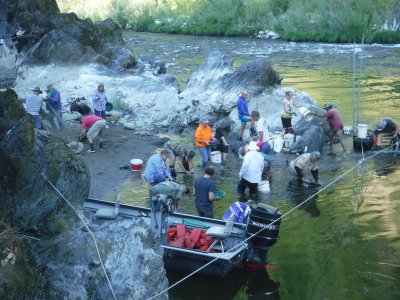 Here is some video we captured of how participants were doing out there on an early Sunday morning:
Here is some video we captured of how participants were doing out there on an early Sunday morning:
When I saw the nuggets being recovered, and the gold in the sample pans, my worries about not finding enough gold were nothing to be concerned about on this day. Here is what we were recovering from the average bucket of screened material:
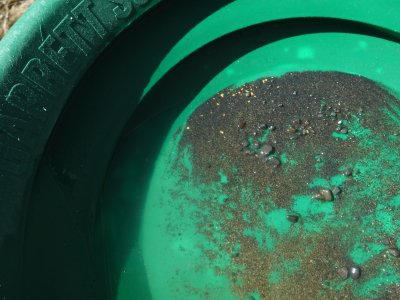
This was the average amount of gold we were recovering out of a bucket a screened pay-dirt!
Once I was certain the program was completely under control, I took the boat back upstream to make certain I was going to be able to get through the rapids that surely added a few dents on the bottom of my boat that morning. Besides the darkness, we were also going through a period where the river level was dropping. There comes a point where it is too shallow to drive the boat through. Before driving several disabled members through that danger zone, I wanted to be sure we could make it with minimal risk. In the daylight, it was no problem to drive the boat through there. Whew!
Still, when it was time to go, I noticed there were two missing from the group of disabled persons. They likely decided their chances of staying alive were better by getting some help climbing the path to where the cars were parked. I can’t say that I blame them! But I will say that it turned out to be a piece of cake to drive the boat up to the developed river access.
On this note; because the river is shallow, I must go up through a set of rapids at full power. This keeps the boat shallower in the river. Here; Diane positioned herself on the side of the river and captured us as we flew by:
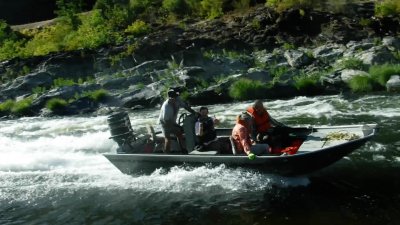
If I can make the time, I also like to step up the adventures for some of our younger members by allowing them (closely supervised) to drive the jet boat up and down through a set of rapids. Here we caught some of the fun on video:
We called it quits at around noon. By this, I mean it was time to stop digging for the project so we could finish processing all the pay-dirt. Holes needed to be filled in, and tools all placed in a single location so I could boat them up to the landing once all the members were transferred across the river. We made plans to meet at our facility in Happy Camp later in the afternoon to do the final clean-up.
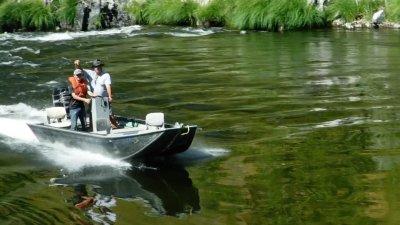
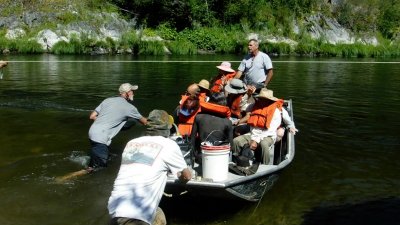
Something important to know about operating motor boats on a river is that the motor must be kept out in the deeper water. Therefore, when launching, you have to push the boat backwards out into the river so the motor does not get caught up in rocks, sand or gravel closer to the edge of the river. Otherwise, the river’s current will push the back of the boat into shallow water and the jet boat will suck in rocks or vegetation and cause the motor to stall. It is not good when this happens, especially when just up river from shallow rapids! Here is some video showing us recover from one of these very situations:
After all the pay-dirt had been processed, we pulled our floating sluice up into a calm, shallow area, disassembled the recovery system, and washed our final product into a large tub. There was a lot of gold visible in the sluice box. Cool!
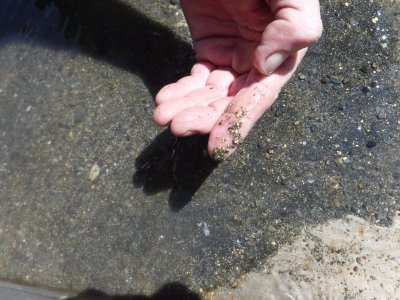
This image is of our concentrates as we cleaned them out of the recovery system. If you look close, you can see the gold.
These gold recovery systems are designed to trap the heaviest material that is washed through them. Gold is the heaviest stuff out there, it being about 19 times heavier than water. Iron is around eight times heavier than water, but it is much heavier than the average material found in most streambeds. The weight of average material differs from one location to the next; but on the Klamath, average gravel weight is around four times heavier than water. So a typical recovery system will recover all or most of the gold, along with a bunch of iron sand – called “black sand.”
We could see a lot of gold in the recovery system. The entire contents went into the Gold Girl’s bucket and Diane asked me to put it safely away in the boat. I took careful control of the gold bucket through the remainder of the day.
We all met at our facility later in the afternoon to do the final clean-up and gold split. We do this in the shade of a tree that adjoins our picnic area. By “final clean-up,” I mean separating all of the gold from all of the black sand and other impurities. Over the many years, we have developed a process to accomplish this without the use of any chemicals.
This is accomplished by classifying the concentrates into several specific sizes and passing each size over ever-slower, more refined recovery systems. We begin by screening the concentrates through an 8-mesh screen. This is usually done out on the river after we have removed the concentrates from the recovery system. Gold nuggets are picked off the screen and put inside our gold bucket. These gold nuggets a are cause for a lot of excitement!
When we meet later in the day, the first thing we do is classify our concentrates through a 10-mesh screen (close to window screen). The material which stays on top of the screen is spread out in a gold pan and the nuggets are picked out with tweezers. This is fun, because the pieces of gold are also rather large and exciting.
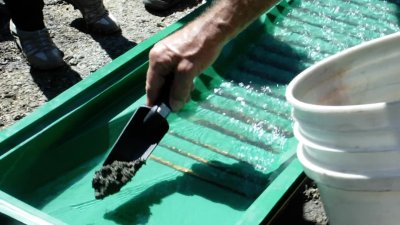
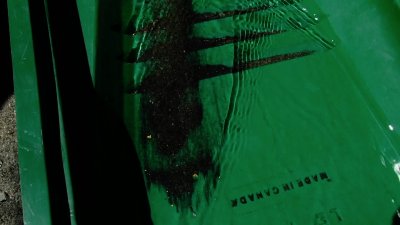
The material that passes through the 10-screen is slowly fed through a Le Trap gold sluice. This is a very well-engineered plastic sluice box which provides nearly perfect gold recovery while reducing the volume of concentrates to about a handful. Craig Colt, then pans the tailings from the Le Trap so all the participants can see how effective the recovery system is. If we find one or two flecks of gold, they are added to our remaining batch of concentrates.
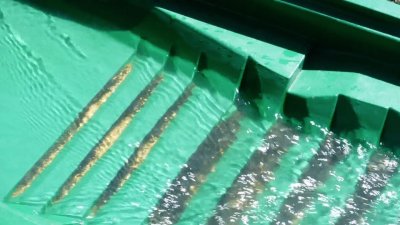
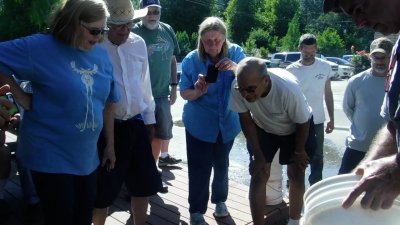
After a while, my assistant, John Rose and helpers came out with all the nuggets we recovered in a small, metal finishing pan. It was a lot of nuggets! All of the participants were excited about that! Participant excitement is like the sound of beautiful music in my world!
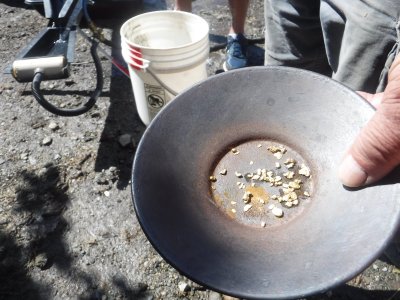 The remaining concentrates are then washed over a smaller, more refined recovery system called a “Gold Extractor.” This is a small sluice with very low profile riffles. If not fed too fast, the Gold Extractor will reduce the volume of concentrates down to about the volume of a tablespoon or two – with zero loss of gold. Craig also pans the tailings from the Gold Extractor to demonstrate to the group how effective this recovery system is. Craig did not find a single speck of gold in the tailings. The following video captured most important parts of the final clean-up:
The remaining concentrates are then washed over a smaller, more refined recovery system called a “Gold Extractor.” This is a small sluice with very low profile riffles. If not fed too fast, the Gold Extractor will reduce the volume of concentrates down to about the volume of a tablespoon or two – with zero loss of gold. Craig also pans the tailings from the Gold Extractor to demonstrate to the group how effective this recovery system is. Craig did not find a single speck of gold in the tailings. The following video captured most important parts of the final clean-up:
We transfer the final concentrates into the small, steel finishing pan with the nuggets, and then I dry the final concentrates over a butane stove. Note that anytime gold is heated up, the process should be done outside in a well ventilated area. We are only heating the concentrates enough to dry them out.
Then the dry concentrates are passed through several different mesh-size screens. Each size is placed on clean sheets of paper inside on a secure table (no chance of it falling down or getting knocked over), away from the wind, dogs, and especially kids that are horsing around. This includes grown up kids! I’m serious about having tight control over the final clean-up steps; because this is the time when some participants really start getting wound up. Sometimes we all get wound up!
We use a magnet to remove perhaps half the remaining concentrates (magnetic iron sand). Then, light blowing over each size easily separates the gold from the remaining impurities. We invite participants to join in this final process.
All of this part is done in the shop-portion of our facility with the large outside doors open so people can come and go as they please. There was a lot of excited chatter as most people gathered around to watch us turn the remaining concentrates into raw gold.
I was really hoping we were going to meet our goal of recovering more than an ounce of gold. But as the blowing process was finishing up, I could see we were not going to make it. It is easy to be fooled into predicting a higher end result when the black sand is adding to the volume.
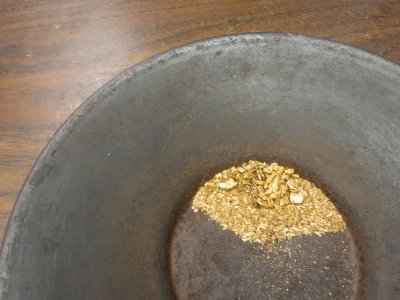 In the end, to my surprise, we recovered a little less than 3/4 of an ounce. It should have been more. The reason I say this is that I watch all or most of the sampling that happens on Sunday morning. We take occasional samples out of the buckets being directed to the floating sluice. We take samples of the raw material people are putting into buckets up on the hillside. The sample results on this project were as good as I can remember. Plus, there were the nuggets.
In the end, to my surprise, we recovered a little less than 3/4 of an ounce. It should have been more. The reason I say this is that I watch all or most of the sampling that happens on Sunday morning. We take occasional samples out of the buckets being directed to the floating sluice. We take samples of the raw material people are putting into buckets up on the hillside. The sample results on this project were as good as I can remember. Plus, there were the nuggets.
We are very careful to capture all the gold and keep it secured in our gold bucket – which remains under very tight control throughout the project.
So are we just over-estimating how much gold we are recovering because we are getting more larger-sized flakes and nuggets? Or are we losing gold in some part of our process? The only place this could have happened in our process is when we were removing fine material from our buckets out in the river or when we washed the pay-dirt over our floating sluice.
As I ponder over this, it occurs to me it is very possible that we fed the sluice too fast. We removed most of the fine sand before processing the pay-dirt. Therefore, the material would have been quite a bit heavier than normal. In some cases, so much fine sand was removed that the pay-dirt was reduced by about 80%. As I think back on it, the final pay-dirt was mostly black-colored like a set of concentrates. We could see gold in with the dark sand.
If you feed a sluice too fast, especially with heavy material, you can overload the riffles to the point where there is no recovery system at all, and the pay-dirt will wash right through into tailings, gold and all.
For example, we could never feed the floating sluice as fast as we do with concentrates out of a recovery system. The riffles in the sluice would become overwhelmed with black sand almost immediately. Perhaps this new method of removing lighter material from our pay-dirt will require us to slow down how fast we are feeding the floating sluice. We will need to be more mindful of this in the coming season.
In the end, there were enough nuggets that everyone ended up with at least one. Some got two. In addition, everyone received a portion of the remaining gold. The shares looked good. Everyone expressed gratitude to me and my helpers. I think most people were happy that the weekend project was finally over. Most people, including me, are not used to the physical activity required in gold mining. Bur if the State would allow us to suction dredge again, I would be back in shape in a matter of weeks!
Recovering gold is very satisfying. But there are other benefits to going out with us on these weekend prospecting adventures. Happy Camp and the Klamath River provide some of the most spectacular Pacific Northwest scenery and wildlife that you will find anywhere. Something about the golden adventure pulls participants together in friendships that will last a lifetime. I caught some of the feelings that members take away with them in the following videos:
But the day was not yet over. Since this was our final weekend project of the season, we pulled all of our gear and the boat off the river after we ferried all the participants across. All that gear had been backed to the rear door of our facility. We were asking for help packing it up the stairs where we have safe, dry storage. There were so many helpers, most people did not need to pack gear upstairs more than once.
Then, with lots of thankyou’s and hugs, everyone went away and left me to enjoy a quiet Sunday evening. This was another very productive mining season for me, and I was thanking my lucky stars for the way I make my living. I consider myself to be very lucky!
2020 Schedule of Events
There is a learning curve to successful gold prospecting. One of the most effective methods of progressing through the learning curve is to go on prospecting adventures with others who more experienced than you are.
Our 2-day Group Mining Projects are one of the primary benefits of New 49’er membership which set us apart from other mining associations. All weekend events are free to Full & Associate Members. All participants share equally in the gold we recover.
Group projects are limited to a certain number of participants. Scheduling in advance is strongly advised to ensure a position on any specific weekend project: 530 493-2012
2020 Schedule of Events: June 20 & 21; July 18 & 19; August 22 & 23.
Planned Office Hours for the Time Being
The upcoming holidays will have our offices closed on December 23, 24 & 25 for Christmas, and January 1 for New Year’s Day.
Until further notice, we will continue opening the doors between 9 AM and 4 PM on weekdays. The office will be closed on weekends, except for the morning hours during the Saturdays when we are sponsoring the coming season’s Weekend Group Projects.
Members are invited to sign in your whereabouts on our properties over the phone in case there is some reason we need to find you.
Our mining properties are freely available to all members in good standing 24 hours a day, 365 days a year, unless the Klamath National Forest is closed due to wildfires.
For any problems, our Internal Affairs is available over the phone: Richard Krimm is our Director of Internal Affairs, email or call (510) 681 8066 (also available after hours and on weekends).
Industry Legal Situation
As many of you know, we have been fighting for more than ten years to overturn the California and Oregon moratoriums on suction dredging. We struggled all the way up through the California Supreme Court – and lost there by a unanimous decision – even when all of the existing law is on our side. Sadly, a substantial portion of America’s judicial system favors the progressive agenda (socialism).
We have struggled to petition the U.S. Supreme Court twice to settle mining right differences on the federal lands between the federal and State governments. The problem is that the Supreme Court only agrees to take up around 5% of the cases requesting a final Decision. In today’s troubled politics, the Court chose other cases which it deemed more important to all of America.
Therefore, until the laws or regulations are changed to our favor, we are not allowed to use any mechanized system to extract or process minerals within 100 yards of any waterway in California and most of Oregon.
We will have another opportunity to obtain a hearing in front of the U.S. Supreme Court. It is just a matter of when. Think of it: The bottom of (many) California and Oregon waterways are loaded with gold. Gold is raw wealth. It is the world’s most important and longstanding financial currency. The gold is there for the taking.
We proved in every study (many) over 40 years that when suction dredging is done according to reasonable regulations, we have never harmed a single fish. But those who have the power to regulate us at the State level do not care. They just want to put an end to us. Truth and justice have nothing to do with it.
For a while, I had strong hopes that the Trump Administration would adopt federal rules which would shield us from the anti-mining interests that are controlling State governments. But “the swamp” may have turned out to be more prevalent and invasive than even Mr. Trump anticipated – and they have, to a large degree, kept him bogged down and distracted by baseless (but serious) accusations during his first three years in office.
At the moment, it is looking hopeful that Mr. Trump and his team could turn the tide on the swamp creatures who have been attacking him. Their addenda is to turn America into a socialist country. We can forget prospecting for gold and most of the other personal freedoms that made America great if the democrats succeed in winning the presidency in the upcoming election. If Mr. Trump holds office for another term, I predict there is a reasonable chance that we will see mining reforms which will limit State authority over federal mining projects (prospecting and mining on the federal lands).
I personally thank all members who have been supporting us with dues payments. The New 49’ers Prospecting Association is doing just fine.
But Legal Fund contributions have dropped off dramatically this past year. We need to encourage more participation if we want to maintain the non-profit status of The New 49’ers Legal Fund. This is important, because the non-profit is basically the only way to raise money for legal matters. Trying to do this through a for profit private company will get us in bigger trouble than we are trying to resolve in the first place!
In case you did not see this, the winners of our October 18 legal drawing are as follows:
Ten 1-Ounce American Silver Eagles: Carol Hatley, Scott McGrosso, Robert Maytum, Bill Jarrell, William White, Stephen Keenan, Brent Harshbarger, Patrick O’Brien, Phillip F. Myska and Robert Rackley.
Ten 1/10th-Ounce American Gold Eagles: Phillip F. Myska, Matt Cottrell, Robert Maytum, Larry Sharpe, William White, Richard Culley, Patrick Matheny, Paul Fender, Walt Morrison and Tom Chambers.
Four 1/4th – Ounce American Gold Eagles: Lenny Rock, David Barna, Joseph Sawyer and Phil Robinson
The Grand Prize: 1-Ounce American Gold Eagle: Christopher Newman
If your name is on the list above and you have not heard from our office, please give our girls a call: 530 493-2012.
Thank you to everyone who contributed to this legal drawing!
The problem is that we are only attracting enough contributions to equal the value of the prizes.
Here is my sincere request for you to continue supporting our political and legal efforts at least until we see what the national political landscape is after the elections this November. I am talking about only three more legal fund-raisers: 14 February and 19 June and 16 October, 2020.
All of America will be substantially affected by the results of the coming election.
Thank you for sticking with us by helping as you are able!
Note: This is not about The New 49’er Mining Association which has thousands of members and makes more than 70 miles of gold-bearing mining properties available to our members. This is about the non-profit fund-raising apparatus that is fighting for reasonable regulations that will allow us the use of mechanized gear and suction dredges so we can regain access to the richest gold deposits – which are mostly at the bottom of existing waterways.
The New 49’ers Legal Fund-raiser!
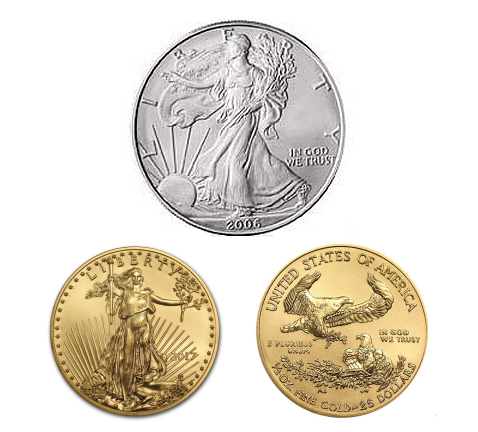 There will be 26 prizes in all:
There will be 26 prizes in all:
Two Grand Prizes: 1/2-ounce American Gold Eagles
Four ¼-ounce American Gold Eagles
Ten 1/10th-ounce American Gold Eagles
Ten 1-ounce American Silver Eagles
Our office will automatically generate a ticket in your name for every $10 legal contribution we receive ($100 would generate 10 tickets).
This drawing will take place at 2 pm on Friday, 14 February 2020, at our headquarters in Happy Camp. You do not need to be a member of our organization to participate. You do not need to be present to win. There is no limit to the size or frequency of your contributions, or to the number of prizes you can win.
Legal contributions can be arranged by calling (530) 493-2012, by mailing to The New 49’ers Legal Fund, P.O. Box 47, Happy Camp, CA 96039, or online:

Happy Holidays to all you guys out there!
Dave McCracken
President, The New 49’ers, Inc.
New 49’er Gold Prospecting Association
27 Davis Road P.O. Box 47, Happy Camp, California 96039 (530) 493-2012
www.goldgold.com








